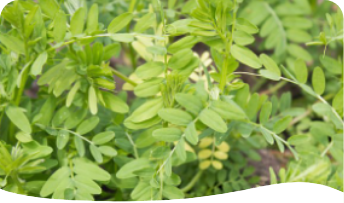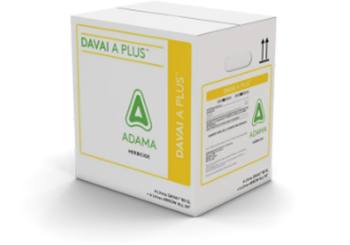WE ARE All In On Pulses & SOYBEANS
At ADAMA, we’re committed to solving your crop protection challenges. By learning directly from growers across Canada, we craft innovative solutions that provide exceptional performance and greater convenience.
Consider our latest fungicide, MAXENTIS®. This powerful solution offers long-lasting, dual-mode protection in one easy-to-use mix. Or DAVAI® A PLUS and DAVAI® Q PLUS, two trusted herbicides that are applied at 40 acres per case. Now, you don’t have to calculate rates – just grab a box and spray. Protecting your crops is simpler than ever.

Q: Where can you find the best products for your fields?
you already have.
All In On your success
Defend your pulse or soybean yield with our high-performance solutions:
Dual-mode MAXENTIS® is a top choice for disease control against white mould (Sclerotinia), anthracnose, and suppression of Mycosphaerella blight. MAXENTIS® is also powered by our Asorbital® Formulation Technology, increasing its uptake and migration for long-lasting results.
When it comes to weed control, the DAVAI® family of products has you covered. DAVAI® A PLUS comes with ARROW ALL IN® herbicide to provide leading grass control, while DAVAI® Q PLUS combines two modes of action for powerful control over broadleaf weeds and stubborn clumping grasses like Persian Darnel and Barnyard Grass.
Innovative Solutions
Learning Center
Control fungicide insensitivity in lentils
According to the Saskatchewan Pulse Growers, anthracnose, the most common lentil disease in Saskatchewan, affected 74% of surveyed fields in 2018 and 92% in 2019.
By the end of the 2019 season, it was confirmed that insensitivity to Group 11 strobilurin fungicides had developed in Saskatchewan. With the risk of fungicide insensitivity rising in Canada, it's important to use a mix of strategies to manage diseases effectively.
Consider these strategies to keep anthracnose disease under control:
- Crop Rotation
- Residue Management
- Seed Quality
- Scouting
- Fungicide Use
When using fungicides, be sure to work with your retailer or agronomist to ensure a proper treatment plan to minimize the risk of developing fungicide insensitivity.
See research that proves MAXENTIS’ effectiveness in controlling Group 11 insensitive anthracnose in lentils.
Maximize yield and profitability with early weed control
To maximize yield and earnings, pay attention to the critical period of weed control (CPWC). During this time, you will want to keep the crop weed free to avoid losing more than 5% of the yield.
For peas, the CPWC is usually up to one or two weeks after crop emergence.
The Impact of Timely Weed Removal
Research studies conducted at Agriculture and Agri-Food Canada (AAFC) showed no decline in pea yields when weeds were removed one week after pea emergence and only a 7% decline after two weeks. However, there was a 12% decline when weed removal happened after three weeks and there was a significant 26% decline after four weeks.
 Source: Harker et al. 1998
Source: Harker et al. 1998
It’s crucial to remove weeds, but it’s also important to spray herbicides early to avoid weed competition. The Saskatchewan Pulse Growers reported that studies in northeast Alberta and the Peace River region showed that spraying at the two-node stage instead of the eight-node stage led to higher pea yields. When sprayed early, the yield increased from 22% to 125% in seven out of 10 times.
When it comes to lentils, studies found that lentils have a CPWC at the start of the five-node stage to the 10-node stage. Additional studies found that applying IMI-herbicides on lentils at the six-node stage led to a 30% higher yield than the two-node stage. For optimal results apply IMI-herbicides such as DAVAI® Q PLUS during the five-to six-node stage.
Crop staging for DAVAI® Q PLUS and
DAVAI® A PLUS
 Discover DAVAI Q PLUS
Discover DAVAI A PLUS
Discover DAVAI Q PLUS
Discover DAVAI A PLUS
Don’t settle: Break free from bundle options
We’ve heard half of prairie farmers are unhappy with bundle options. If you feel like crop input bundles and programs are restricting your choices and forcing you to buy from only select companies, rather than having the freedom to shop where you want, you’re not alone. Thankfully, ADAMA offers a wide range of innovative solutions and exceptional alternatives for Canadian pulse growers.
 All products are trademarks of their respective companies.
All products are trademarks of their respective companies.
PEAS
From in-crop to disease control, ADAMA has a full suite of innovative solutions to protect the yield potential of your peas all season long.
The product was a convenient liquid formulation that flowed nicely. It was easy to pour into the handler and go.
Trial Grower – Eston, SK
MAXENTIS®
 Click to enlarge
Click to enlarge

Pea Solutions
For over two decades, Canadian pea growers looking for crop protection solutions haven’t had much of a choice. So, we’re shaking things up. Click to see our pea solutions.

Put the squeeze on your weeds
PYTHON® combines two powerful actives for resistance management and broad spectrum weed control, including wild mustard and volunteer canola (all types).
LENTILS
Leverage your lentil acres with the world’s largest library of actives from ADAMA. We’re all in on flexible, effective protection for IMI-tolerant lentils.
On average MAXENTIS® had a 4 bu/acre yield increase over the untreated check in our lentil trials and consistently was best in class.
MAXENTIS®
 Click to enlarge
Click to enlarge

Lentil Solutions
See our portfolio of herbicides, fungicides & insecticides to protect your lentils this season. Click below for our lentil solutions.

Get more from your IMI-tolerant lentils
DAVAI Q PLUS was specifically designed with dual modes of action to control stubborn winter annuals in Imidazolinone-tolerant lentils.
SOYBEANS
Growing soybeans this season? Explore ADAMA’s complete lineup of innovative solutions to protect your soybean yield potential all season long.
Southbrae Farms in Teviotdale, Ontario, saw a 4 bu/acre increase in yield versus Delaro® Complete.
MAXENTIS®
 Click to enlarge
Click to enlarge

Soybean Solutions
The largest library of actives in the world brings you more options for Soybeans. See our portfolio of herbicides, fungicides & insecticides below.

Control RR canola in soybeans
DAVAI A PLUS, a two modes of action herbicide, has conveniently packaged DAVAI® 80 SL and ARROW ALL IN® to effectively control volunteer canola…even canola resistant to glyphosate.

Sign up for the ADAMA Innovations Newsletter.
Receive information on our newest products, formulation improvements, online tools and other agronomic resources – for free!
We want to help
If you’ve got questions about our innovative lineup of pulse products or want help improving your yield performance, your local ADAMA representative is only a call away.
Find your rep



